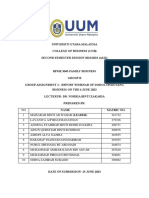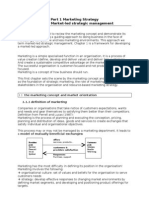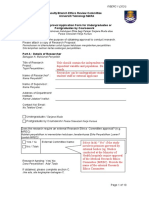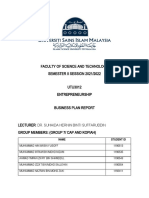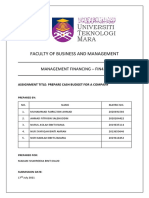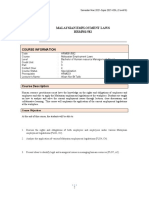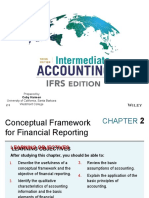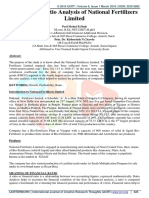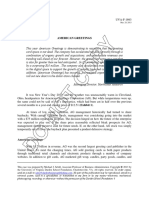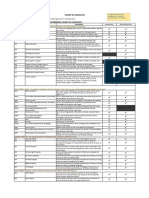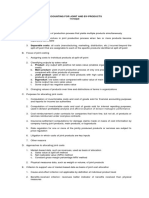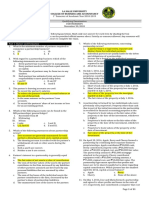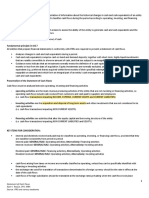Revision questions MGT657 2024 ANSWER
Uploaded by
2023680368Revision questions MGT657 2024 ANSWER
Uploaded by
2023680368Revision questions
1. Evaluate three (3) of the strategies that you might recommend, if the Strategic Position
and Action Evaluation (SPACE) Matrix directional vector points to the lower left
quadrant? (25 Marks)
If the Strategic Position and Action Evaluation (SPACE) Matrix directional vector points to the
lower left quadrant, it indicates that the organization is in a weak competitive position and
operates in an unstable industry. This situation calls for a defensive posture, with strategies
focusing on minimizing losses and stabilizing the organization. Three recommended strategies
for this scenario are liquidation, retrenchment, and related diversification.
Liquidation involves selling off the company’s assets to pay debts or generate cash for
shareholders, often resulting in the permanent closure of operations. This strategy is
advantageous because it provides a resolution to severe financial distress and ensures the
recovery of some value for stakeholders rather than continuing unprofitable operations.
However, liquidation is often seen as a last resort due to its irreversible nature, leading to job
losses and potential reputational damage. It is most suitable for businesses facing
insurmountable financial challenges where survival is no longer feasible.
Retrenchment focuses on reducing the scope of operations through cost-cutting measures,
downsizing, or selling off non-core assets to improve financial health. This approach allows an
organization to stabilize by concentrating on its core strengths and redirecting resources
toward profitable areas. While retrenchment can free up resources and improve operational
efficiency, it may lead to employee morale issues due to layoffs and a potential loss of market
share in scaled-back areas. It is an ideal strategy for companies with the potential to recover
by streamlining their operations.
Related diversification entails expanding into industries or markets closely related to the
organization’s core business. This strategy leverages existing competencies and resources,
opening new revenue streams while maintaining operational synergies. The benefits of related
diversification include reduced risk compared to unrelated diversification and the opportunity
to capitalize on existing strengths. However, it requires a significant investment, which may
strain already limited resources, and success depends on effective integration and execution.
This strategy is appropriate for companies with sufficient resources and expertise to explore
related markets or products while mitigating risks in their current operations.
In conclusion, liquidation is a drastic and irreversible strategy suitable only when recovery is
not feasible, while retrenchment offers a moderate approach to stabilize and recover. Related
diversification provides a growth-oriented strategy for companies with competitive strengths
that can be leveraged in aligned markets. The choice of strategy depends on the
organization's financial condition, resource availability, and long-term objectives.
2. Examine four (4) types of strategy from Strength-Weaknesses-Opportunities-Threats
(SWOT) matrix (25 marks)
The SWOT matrix is a tool that helps organizations develop strategies based on their
strengths, weaknesses, opportunities, and threats. It provides four main types of strategies:
Strength-Opportunities (SO), Weakness-Opportunities (WO), Strength-Threats
(ST), and Weakness-Threats (WT). Each type focuses on a different combination of these
factors to guide decision-making.
SO (Strength-Opportunities) strategies focus on using the organization’s strengths to
take advantage of opportunities in the environment. These strategies aim to maximize the
potential for growth and success. For example, a company with a strong brand might expand
into new markets to attract more customers. This type of strategy works best for
organizations that already have strong internal capabilities and are looking to grow further by
capitalizing on favorable conditions.
WO (Weakness-Opportunities) strategies focus on improving weaknesses so the
organization can benefit from external opportunities. For instance, if a company lacks
advanced technology, it might invest in upgrading its systems to meet market demands.
These strategies help the organization turn its weaknesses into strengths and prepare to take
advantage of opportunities that can lead to growth and improvement.
ST (Strength-Threats) strategies aim to use the organization’s strengths to reduce or
overcome external threats. For example, a company with strong customer loyalty might focus
on retaining its market share when faced with new competitors. These strategies are about
staying competitive and protecting the business from risks by relying on its existing
advantages.
WT (Weakness-Threats) strategies are defensive approaches designed to minimize
weaknesses and avoid threats. For example, a company facing financial difficulties and market
competition might downsize or cut unnecessary expenses to survive. These strategies are
used when the organization is in a challenging situation and needs to focus on stability and
survival.
In summary, the four strategies from the SWOT matrix—SO, WO, ST, and WT—help
organizations address different challenges and opportunities. SO strategies focus on growth,
WO strategies focus on improvement, ST strategies focus on protection, and WT strategies
focus on survival. The choice of strategy depends on the organization’s specific situation and
goals.
3. Examine any three (3) strategies from quadrants Dog in Boston Consultant Group (BCG)
matrix (15 marks)
The Boston Consulting Group (BCG) matrix is a tool used to analyze an
organization’s product or business portfolio based on market growth and market share.
Products or businesses in the Dog quadrant have low market share in a low-growth industry.
These are often considered weak positions, and organizations must decide whether to
improve, sell, or close these units. Three strategies that can be applied to businesses in the
Dog quadrant are diversification, retrenchment, and divestiture.
Diversification is a strategy where the organization expands into new markets or develops
new products to improve its performance. For businesses in the Dog quadrant, diversification
offers a way to escape stagnant markets and low demand. For example, a company selling
outdated products might develop a modern version or enter a completely new industry. This
strategy requires careful planning and resources, but it can provide a fresh start and help the
company create new revenue streams.
Retrenchment focuses on reducing costs and narrowing the scope of operations to stabilize
the business. This strategy is useful for Dog quadrant units that still have potential but need
to become more efficient. For example, a company might close underperforming locations or
cut unnecessary expenses to focus on its strongest products or markets. Retrenchment allows
the organization to rebuild its strength and improve profitability by addressing internal
inefficiencies.
Divestiture involves selling or closing the business unit to cut losses and redirect resources
to more profitable areas. For a product or business in the Dog quadrant, divestiture can free
up resources that can be better used elsewhere. For example, a company might sell a failing
division to another firm that can make better use of it. This strategy helps the organization
focus on its core strengths and avoid wasting time and money on unprofitable ventures.
In conclusion, businesses in the Dog quadrant face significant challenges, but strategies like
diversification, retrenchment, and divestiture offer ways to address these issues.
Diversification provides an opportunity for growth in new areas, retrenchment focuses on
making the business more efficient, and divestiture helps eliminate losses and refocus
resources. The choice of strategy depends on the organization’s goals and the potential of the
business in question.
4. Explain any two (3) major regions from Internal-External (IE) matrix (10 marks)
The Internal-External (IE) matrix helps businesses analyze their internal strengths and
weaknesses alongside external opportunities and threats. It categorizes companies into three
regions, each suggesting different strategic actions.
Grow and Build Region: This region is for companies with strong internal capabilities and
favorable external conditions. These companies should focus on growth strategies like market
expansion or new product development.
Example: A technology company could develop new products or expand into new regions.
Hold and Maintain Region: Companies in this region have stable internal capabilities but
face slow market growth. They should focus on maintaining their position by improving
efficiency and customer loyalty.
Example: A manufacturing company might improve operations rather than aggressively
expand.
Harvest or Divest Region: Companies in this region are weak both internally and externally.
The strategy here is to reduce costs, maximize short-term profits, or divest non-profitable
parts of the business.
Example: A declining retail store might sell off unprofitable locations or close down entirely.
In conclusion, the IE matrix helps companies choose strategies based on their competitive
position and market conditions: aggressive growth, stability, or minimizing losses.
5. Examine three (3) strategies from quadrant that located in strong competitive position
but has slow market growth from the Grand Strategy matrix (15 marks)
In the Grand Strategy Matrix, companies in a strong competitive position but facing slow
market growth typically fall in the second quadrant. To maintain success, these businesses can
adopt strategies like related diversification, unrelated diversification, and joint ventures.
Related Diversification
Description: Expanding into products or services related to the company's core business to
leverage existing strengths and reduce risks.
Example: A company making computer components might expand into related products like
accessories or software.
Unrelated Diversification
Description: Entering completely new markets or industries to reduce risk and explore new
growth opportunities.
Example: A consumer goods company entering the financial services industry to grow outside
its current market.
Joint Ventures
Description: Partnering with another company to enter a new market or develop a new
product, sharing resources and risks.
Example: A manufacturing company partnering with a tech firm to create smart home devices.
Conclusion
For companies in slow-growing markets, related diversification, unrelated diversification, and
joint ventures are strategies that can support growth. The choice of strategy depends on the
company's resources and goals, helping them remain competitive in challenging market
conditions.
6. Briefly explain four (4) strategic marketing issues or decisions. (10 marks)
Strategic marketing involves important decisions that shape a company’s ability to succeed.
Four key marketing issues or decisions include making advertisements more interactive,
becoming a price leader, and creating a new line of products.
1. How to Make Advertisements More Interactive
Description: Interactive ads engage customers by encouraging participation, such as through
quizzes or social media polls. This helps build stronger customer connections and brand
loyalty.
Example: A company might create an Instagram poll where users vote on new product
designs, making the experience more engaging.
2. How to Be a Price Leader
Description: Being a price leader means offering lower prices than competitors to attract more
customers. Companies can use discounts, bundling, or value offers to position themselves as
the lowest-cost option.
Example: A retail chain offering regular sales or discounts to attract price-conscious
consumers.
3. How to Create a New Line of Products
Description: Introducing a new product line allows companies to diversify and reach new
markets. This decision involves identifying market trends and gaps in the current product
offerings.
Example: A skincare brand might launch a line of organic cosmetics to meet the growing
demand for natural products.
Conclusion
Making decisions on interactive advertising, pricing strategies, new product lines, and
distribution channels are essential in strategic marketing. These decisions help companies
engage customers, stay competitive, and grow in the market.
7. Explain three (ways) on how to manage conflict (15 marks)
Effectively managing conflict is important for maintaining a positive environment. Here are
three key ways to manage conflict:
1. Open Communication
Description: Encourage honest and clear communication to address misunderstandings.
Everyone should have a chance to express their views calmly.
Example: In a workplace disagreement, a meeting where each person explains their
perspective can help resolve the issue.
2. Active Listening
Description: Pay full attention, show empathy, and reflect on what is being said to ensure
understanding. This helps reduce tension and shows respect.
Example: If colleagues disagree, listening without interrupting and paraphrasing what’s heard
can defuse the conflict.
3. Compromise and Collaboration
Description: Find a middle ground by compromising or collaborating to meet both parties’
needs. This turns conflicts into opportunities for better solutions.
Example: Team members can combine their ideas to come up with a solution that satisfies
everyone.
Conclusion
Managing conflict through open communication, active listening, and compromise or
collaboration helps resolve issues, foster respect, and improve teamwork.
8. Examine any two (2) causes of ineffective organisational structure (10 marks)
Ineffective organizational structures can hinder a company's ability to function efficiently. Here
are two common causes of such inefficiencies:
1. Lack of Clear Roles and Responsibilities
Description: When roles and responsibilities are not clearly defined, employees may be unsure
of what is expected of them. This confusion can lead to overlapping tasks, missed deadlines,
and a lack of accountability. It can also create conflicts between departments or individuals,
affecting overall productivity.
Example: In a company where job roles are not clearly outlined, two teams might end up
working on similar tasks without coordination, leading to duplicated efforts and wasted
resources.
2. Poor Communication Channels
Description: Ineffective communication is a major cause of organizational structure problems.
If communication between departments or levels of management is weak, important
information may not be shared in a timely manner, leading to misunderstandings or delays in
decision-making.
Example: In an organization with poor communication, employees may not be aware of
important changes or updates, resulting in confusion or decisions being made without the
necessary information.
Conclusion
Ineffective organizational structures often arise from lack of clear roles and poor
communication. These issues can cause confusion, inefficiency, and conflict, making it harder
for the organization to meet its goals.
9. Discuss four (4) corporate valuation methods or approaches for determining a business'
monetary value (25 marks)
When determining a business's monetary value, companies use various valuation methods to
assess their worth. Below are four commonly used approaches:
Net Worth Method
The net worth method evaluates a business by calculating its total assets minus its liabilities.
This approach focuses on the company's financial stability and the tangible resources it owns.
It is straightforward and provides a clear picture of the company’s intrinsic value, making it a
reliable option for businesses with significant physical or financial assets.
Net Income Method
The net income method determines the value of a business based on its profitability. It
evaluates the company's annual net income and applies a multiplier to estimate its total
value. This approach is beneficial for businesses that generate consistent profits and helps
investors predict the potential return on investment.
Price-Earnings Ratio (P/E) Method
The price-earnings ratio method values a business by comparing its market price per share to
its earnings per share. This ratio is then multiplied by the company's earnings to calculate its
total value. This method is commonly used in public companies as it reflects market
sentiment and future earnings potential, making it attractive for investors who value growth.
Outstanding Shares Method
The outstanding shares method calculates the value of a business by multiplying the total
number of its outstanding shares by the current market price per share. This approach is
suitable for publicly traded companies and reflects their market capitalization, offering a real-
time indicator of their worth.
Each of these methods provides unique insights into a company's value, catering to different
types of businesses and investor needs. By understanding these approaches, stakeholders
can make informed decisions about investments, acquisitions, or other financial matters.
10. Explain three (3) stage from strategy-formulation analytical framework. (15 marks)
The strategy-formulation analytical framework is essential for organizations to identify,
evaluate, and implement strategies effectively. This framework consists of three key stages:
1. Input Stage
The input stage involves gathering essential information to understand the organization’s
current situation. Tools like the External Factor Evaluation (EFE) matrix, Internal Factor
Evaluation (IFE) matrix, and Competitive Profile Matrix (CPM) are used. These tools analyze
external opportunities and threats, internal strengths and weaknesses, and the competitive
environment. The input stage provides a solid foundation for decision-making by presenting
an accurate picture of the organization’s position.
2. Matching Stage
In the matching stage, the focus is on aligning the organization’s strengths with opportunities
while minimizing weaknesses and avoiding threats. This stage uses tools like the SWOT
analysis, Strategic Position and Action Evaluation (SPACE) matrix, and the Boston Consulting
Group (BCG) matrix. The goal is to generate viable strategic options that ensure a good fit
between the internal and external environments of the business.
3. Decision Stage
The decision stage involves selecting the best strategy from the options generated in the
matching stage. Techniques like the Quantitative Strategic Planning Matrix (QSPM) are used to
evaluate and prioritize strategies based on their attractiveness and feasibility. This stage
ensures that the chosen strategy aligns with organizational goals and resources, enabling
effective implementation.
By progressing through these stages, organizations can systematically formulate strategies
that lead to sustainable competitive advantages and long-term success.
11. Discuss three (3) potential strategic production/operations issues that can significantly
influence attaining objectives. (10 marks)
Strategic production and operations management play a critical role in achieving
organizational objectives. However, certain issues can significantly influence their success.
Below are three key issues:
Capacity Management
Inefficient capacity planning can lead to underutilization of resources or overburdening of
production facilities. If a business fails to align its production capacity with market demand, it
risks delayed delivery times, increased costs, or loss of customer satisfaction. Strategic
capacity planning ensures that resources are effectively utilized to meet demand without
incurring unnecessary expenses.
Quality Control and Assurance
Maintaining consistent product quality is essential for customer satisfaction and brand
reputation. Poor quality management can result in defective products, increased warranty
claims, or product recalls, harming the company’s image and profitability. A robust quality
assurance system helps prevent such issues by implementing strict production standards and
regular inspections.
Supply Chain and Inventory Management
Disruptions in the supply chain, such as delays in material delivery or poor inventory control,
can halt production and delay product delivery to customers. Strategic supply chain
management ensures a reliable flow of materials and prevents overstocking or stockouts,
which can negatively impact cash flow and operational efficiency.
Addressing these strategic issues is vital for smooth operations and achieving organizational
goals. By focusing on efficient capacity planning, quality control, and supply chain
management, businesses can enhance their production processes and meet their objectives
effectively.
12. Determine how financial ratios, initial public offerings (IPOs) and issuing bonds can raise
strategic decision issues (15 marks)
Financial ratios, initial public offerings (IPOs), and issuing bonds are critical tools in strategic
financial decision-making. Each can significantly influence a company’s strategy and
operations, presenting both opportunities and challenges.
1. Financial Ratios
Financial ratios provide insights into a company's performance, efficiency, liquidity, and
profitability. Ratios such as debt-to-equity, return on investment (ROI), and current
ratio help assess the financial health of the business. However, overreliance on these
metrics may lead to short-term decision-making, neglecting long-term growth.
Additionally, interpreting ratios without considering industry norms or external factors
can result in flawed strategic decisions. For instance, a high debt-to-equity ratio might
signal the need to reduce debt, potentially limiting investment in growth opportunities.
2. Initial Public Offerings (IPOs)
Going public through an IPO can provide substantial capital to fund expansion,
innovation, or acquisitions. However, it also introduces strategic challenges such as
compliance with regulatory requirements, pressure to deliver short-term results to
satisfy shareholders, and loss of control for existing owners. The decision to go public
requires careful evaluation of market conditions and readiness, as poor timing or
inadequate preparation can negatively affect the company’s valuation and reputation.
3. Issuing Bonds
Issuing bonds is an effective way to raise capital without diluting ownership, making it
an attractive option for strategic financing. However, it increases the company's debt
obligations, which may strain cash flow and elevate financial risk during economic
downturns. Businesses must balance the benefits of leveraging debt with the potential
risks, ensuring that they can meet interest and principal payments without jeopardizing
operations.
Each of these financial tools requires thorough analysis and strategic alignment to ensure that
they contribute to the organization’s long-term objectives while managing associated risks
effectively.
13. Describe three (3) phases in strategy evaluation (25 marks)
Strategy evaluation is a critical process that ensures an organization stays on track to achieve
its objectives. It involves three key phases that collectively assess and refine a firm’s strategy
for optimal performance:
1. Examine the Underlying Basis of a Firm's Strategy
The first phase involves assessing whether the foundation of the organization’s
strategy remains valid in the face of changing external and internal environments. This
includes analyzing factors such as market conditions, competitive dynamics, and
internal strengths and weaknesses. By revisiting the assumptions and data that
informed the initial strategy, businesses can identify any shifts that require
adjustments. For instance, a significant change in consumer behavior or technology
could render parts of a strategy outdated, prompting a reevaluation.
2. Compare Expected Results with Actual Results
The second phase focuses on measuring the organization’s performance by comparing
actual results against the expected outcomes outlined in strategic plans. Key
performance indicators (KPIs) such as sales growth, profit margins, or market share
are evaluated to determine whether the strategy is yielding the desired results.
Discrepancies between expectations and reality highlight areas where the strategy may
be underperforming, allowing managers to identify potential issues and areas for
improvement.
3. Take Corrective Actions to Ensure Performance Conforms to Plans
The final phase involves implementing necessary changes to align performance with
strategic goals. Corrective actions may include revising targets, reallocating resources,
improving processes, or even redefining parts of the strategy. This phase ensures that
the organization remains flexible and responsive to deviations, maintaining its
competitive edge and long-term success. Effective communication and leadership are
crucial during this stage to ensure that adjustments are understood and executed
effectively.
By systematically addressing these three phases, organizations can ensure their strategies
remain relevant, effective, and aligned with their goals in a dynamic business environment.
14. Explain three (3) reason why business ethic are important in organisation (15 marks)
Business ethics play a crucial role in shaping the culture, reputation, and success of an
organization. Below are three key reasons why business ethics are essential:
1. Builds Trust and Credibility
Ethical practices foster trust among employees, customers, investors, and other
stakeholders. When an organization consistently demonstrates honesty, transparency,
and fairness, it enhances its credibility. This trust strengthens relationships,
encourages loyalty, and attracts new customers and partners, providing a competitive
edge in the marketplace. For example, companies known for ethical practices are more
likely to retain customers and sustain long-term growth.
2. Ensures Legal Compliance and Reduces Risks
Adhering to business ethics helps organizations comply with laws and regulations,
reducing the risk of legal penalties and reputational damage. Ethical behavior ensures
that businesses avoid unethical practices such as fraud, discrimination, or
environmental harm, which could result in costly lawsuits or fines. By embedding ethics
into their operations, organizations can safeguard themselves against financial and
legal risks, ensuring stability and sustainability.
3. Promotes a Positive Workplace Culture
Ethical organizations create a positive and inclusive work environment where
employees feel valued and respected. When leaders prioritize integrity, fairness, and
respect, they inspire employees to uphold these values. This fosters collaboration,
boosts morale, and enhances productivity. Additionally, ethical practices reduce
workplace conflicts and unethical behavior, creating a culture where employees are
motivated to contribute to organizational success.
In summary, business ethics are vital for building trust, ensuring legal compliance, and
fostering a positive workplace culture. Organizations that prioritize ethical behavior are more
likely to achieve sustainable success while maintaining their reputation and stakeholder
confidence.
15. Discuss three (3) reason why business need to give commitment in environment (15
marks)
Businesses have a significant impact on the environment and are increasingly expected to
demonstrate commitment to sustainable practices. Below are three key reasons why
environmental commitment is essential:
1. Enhances Corporate Reputation and Brand Value
Commitment to the environment strengthens a business’s reputation and brand image.
Consumers today are more environmentally conscious and prefer to support businesses
that prioritize sustainability. By adopting eco-friendly practices, such as reducing
carbon emissions, minimizing waste, and using renewable resources, businesses can
attract environmentally conscious customers and build loyalty. A strong reputation for
environmental responsibility also distinguishes the organization in competitive markets.
2. Ensures Regulatory Compliance and Avoids Penalties
Governments and regulatory bodies are enforcing stricter environmental laws and
policies to combat climate change and protect natural resources. Businesses that
commit to the environment can proactively comply with these regulations, avoiding
fines, sanctions, or operational disruptions. Beyond compliance, environmental
stewardship demonstrates that a business is forward-thinking and prepared to adapt to
evolving legal and societal expectations.
3. Supports Long-Term Sustainability and Cost Efficiency
Environmental commitment is not just about ethics—it also supports long-term
business sustainability. Practices such as energy efficiency, waste reduction, and
sustainable resource management often lead to cost savings. For example, investing in
renewable energy can reduce operational costs over time, while minimizing waste can
lower disposal expenses. Moreover, sustainable practices help preserve natural
resources essential for business operations, ensuring long-term viability and success.
In conclusion, a strong commitment to the environment enhances reputation, ensures
compliance, and promotes sustainability. By integrating environmental responsibility into their
strategies, businesses can achieve financial benefits while contributing to the well-being of the
planet and society.
16. Determine five (5) challenges in strategic management (25 marks)
Strategic management is essential for achieving organizational goals, but it comes with several
challenges. Below are five key challenges businesses often face in strategic management:
1. Adapting to Rapid Changes in the External Environment
The business environment is constantly evolving due to factors such as technological
advancements, economic fluctuations, and regulatory changes. Companies must
continuously monitor and adapt to these changes to remain competitive. Failure to
respond effectively can lead to outdated strategies and missed opportunities.
2. Aligning Strategy with Organizational Resources
Strategic plans often require significant resources, including finances, personnel, and
technology. Ensuring that the organization’s resources align with its strategy can be
challenging, especially for businesses with limited capabilities. Misalignment may result
in underperformance, inefficiencies, or failure to achieve objectives.
3. Managing Resistance to Change
Implementing new strategies often requires changes in processes, structures, or
cultures, which can face resistance from employees or stakeholders. Overcoming this
resistance requires effective communication, leadership, and change management
strategies to ensure buy-in and support for the new direction.
4. Balancing Short-Term and Long-Term Objectives
Organizations often struggle to balance immediate financial results with long-term
strategic goals. Focusing too much on short-term profits can undermine investments in
innovation, sustainability, or growth initiatives, while excessive emphasis on long-term
objectives may neglect current operational performance.
5. Measuring and Monitoring Performance
Evaluating the success of a strategy requires robust performance metrics and
monitoring systems. Identifying appropriate key performance indicators (KPIs) and
gathering accurate data can be challenging. Without effective measurement,
businesses may fail to identify gaps or areas for improvement, jeopardizing the
strategy’s success.
Addressing these challenges requires strong leadership, flexibility, and a commitment to
continuous improvement. By proactively managing these obstacles, organizations can enhance
their strategic management processes and achieve sustainable success.
You might also like
- (BPME3043 - Group B) Dodol Opah Yang Report WebinarNo ratings yet(BPME3043 - Group B) Dodol Opah Yang Report Webinar29 pages
- Acc407 - Final Project (Simulation) - InstructionsNo ratings yetAcc407 - Final Project (Simulation) - Instructions2 pages
- Mcdonald'S, A Guide To The Benefits of Jit: Just-In-Time (Jit)No ratings yetMcdonald'S, A Guide To The Benefits of Jit: Just-In-Time (Jit)7 pages
- OPM549 - Assignment 1 - NUR FATMA SYAZANA MOHD HILMI - 2018808652No ratings yetOPM549 - Assignment 1 - NUR FATMA SYAZANA MOHD HILMI - 20188086527 pages
- TUTORIAL QUESTION 3-Adm501 Presentation Slide Assignment MUZHAFARR & FARAHNo ratings yetTUTORIAL QUESTION 3-Adm501 Presentation Slide Assignment MUZHAFARR & FARAH14 pages
- Date Work Summary/Daily Activities Duration RemarksNo ratings yetDate Work Summary/Daily Activities Duration Remarks15 pages
- 1-Hanbook - Project - Ebtp4106 - BTM & BMMG & BPFMNo ratings yet1-Hanbook - Project - Ebtp4106 - BTM & BMMG & BPFM23 pages
- Nureen Batrisyia 2021118269 Profiling ReportNo ratings yetNureen Batrisyia 2021118269 Profiling Report80 pages
- SUBWAY PROJECT REPORT-SılaFarukBegümMertNo ratings yetSUBWAY PROJECT REPORT-SılaFarukBegümMert22 pages
- Quiz 2.: Cross Cultural Management - Ver EngNo ratings yetQuiz 2.: Cross Cultural Management - Ver Eng2 pages
- Group Assignment 3 (CB Telaga Hijau BHD)No ratings yetGroup Assignment 3 (CB Telaga Hijau BHD)5 pages
- Learning From Failure Hrm645 Script & OutlineNo ratings yetLearning From Failure Hrm645 Script & Outline12 pages
- Community Service: Subject Code: Mpu3442 Lecturer Name: Muhammad Remy Bin OthmanNo ratings yetCommunity Service: Subject Code: Mpu3442 Lecturer Name: Muhammad Remy Bin Othman26 pages
- Business Intelligence and Inventory A Case Study of Dicks Sporting Goods 29-06-2007No ratings yetBusiness Intelligence and Inventory A Case Study of Dicks Sporting Goods 29-06-200717 pages
- Malaysian Employment Laws HRM581/582: Course InformationNo ratings yetMalaysian Employment Laws HRM581/582: Course Information7 pages
- Strategic MGT Chapter 4 (Last Modified New2003) 222No ratings yetStrategic MGT Chapter 4 (Last Modified New2003) 2229 pages
- Chapter 02. Conceptual Framework For Financial ReportingNo ratings yetChapter 02. Conceptual Framework For Financial Reporting55 pages
- Practice questions for mid term test 1-sentNo ratings yetPractice questions for mid term test 1-sent6 pages
- Dolphin Hotels PLC and Eden Hotel Lanka PLCNo ratings yetDolphin Hotels PLC and Eden Hotel Lanka PLC7 pages
- A Financial Ratio Analysis of National Fertilizers Limited: Prof - Mehul B.ShahNo ratings yetA Financial Ratio Analysis of National Fertilizers Limited: Prof - Mehul B.Shah7 pages
- CA Inter - Nov 2018 - F M & Eco For Finance - Suggested AnswersNo ratings yetCA Inter - Nov 2018 - F M & Eco For Finance - Suggested Answers25 pages
- Assignment: Dr. Gazi Mohammad Hasan Jamil SL No. Name Student IDNo ratings yetAssignment: Dr. Gazi Mohammad Hasan Jamil SL No. Name Student ID26 pages
- Fraud Examination 3rd Edition Albrecht Solutions Manual all chapter instant download100% (3)Fraud Examination 3rd Edition Albrecht Solutions Manual all chapter instant download42 pages



